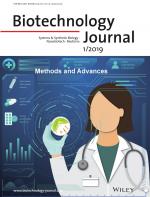An extracellular polymer at the interface of magnetic bioseparations
- Citation:
- Dhadge, VL, Morgado PI, Freitas F, Reis MA, Azevedo AM, Aires-Barros R, Roque ACA. 2014. An extracellular polymer at the interface of magnetic bioseparations. Journal of the Royal Society Interface. 11(100):20140743.
Abstract:
FucoPol, a fucose-containing extracellular polysaccharide (EPS) produced by bacterium Enterobacter A47 using glycerol as the carbon source, was employed as a coating material for magnetic particles (MPs), which were subsequently functionalized with an artificial ligand for the capture of antibodies. The performance of the modified MPs (MP–EPS-22/8) for antibody purification was investigated using direct magnetic separation alone or combined with an aqueous two-phase system (ATPS) composed of polyethylene glycol (PEG) and dextran. In direct magnetic capturing, and using pure protein solutions of human immunoglobulin G (hIgG) and bovine serum albumin (BSA), MP–EPS-22/8 bound 120 mg hIgG g−1 MPs, whereas with BSA only 10 ± 2 mg BSA g−1 MPs was achieved. The hybrid process combining both the ATPS and magnetic capturing leads to a good performance for partitioning of hIgG in the desired phase as well as recovery by the magnetic separator. The MPs were able to bind 145 mg of hIgG g−1 of particles which is quite high when compared with direct magnetic separation. The theoretical maximum capacity was calculated to be 410 ± 15 mg hIgG adsorbed g−1 MPs with a binding affinity constant of 4.3 × 104 M−1. In multiple extraction steps, the MPs bound 92% of loaded hIgG with a final purity level of 98.5%. The MPs could easily be regenerated, recycled and re-used for five cycles with only minor loss of capacity. FucoPol coating allowed both electrostatic and hydrophobic interactions with the antibody contributing to enhance the specificity for the targeted products.







